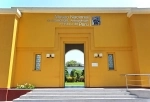National Museum of Archeology, Anthropology and History of Peru. Lima - PERU
Direccion:
Plaza Bolivar, Pueblo Libre 15084 Phone: + 51 1 3215630
Web:
www.mnaahp.cultura.pe/ The National Museum of Archeology, Anthropology and History of Peru is the first museum in Peru, the largest, oldest and most representative.
The Museum building has an architecture that combines elements from the Late Colonial and Republican periods.
The first collections of the museum consisted of mineral and vegetable specimens typical of the local geography and the cultural vestiges of the pre-Hispanic era. Throughout the nineteenth century its exhibition spaces were located in various institutional houses of the State, as for example in the Ministry of Foreign Affairs, then in the National Library and the chapel of the Inquisition, to end up settling on the top floor of the Palace of the Exhibition.
Permanent Exhibitions:
Origins: From the origin of the first hominids in Africa to the settlement of Homo sapiens in the Americas
Formative: Pottery between 2000 and 200 a.c.
Chavin: Highlights the presence of large and lavish ceremonial centers designed to meet the needs of the growing population.
Pukara: Shows the culture of the Peruvian-Bolivian Altiplano, between 500 and 380 AD
Paracas: One of the most outstanding formative cultures of the southern coast of the central Andes
Regional Developments: Here we present the best known expressions of the period between 0 and 800 d. C. such as Vicús, Salinar, Virú, Moche, and Lima, located on the coast, and Cajamarca and Recuay in the mountains.
Metallurgy: The room expresses the entire production process. Metallurgy begins with obtaining the metal, either from its native state or minerals.
Huari: Represents the first imperial phenomenon emerged in the Peruvian territory, in the region of Ayacucho, between 600 and 1000 d. C. and that reached a great urban development.
Chancay: The culture, developed between 1100 and 1400 d. C. in the central coast, is characterized by a high agricultural and urban development.
Chimú / Lambayeque: Chimú and Lambayeque, between the years 700 and 1400 d. C., are the cultures of the Late Intermediate Period more representative of the north coast. Both are heirs of the Moche culture.






